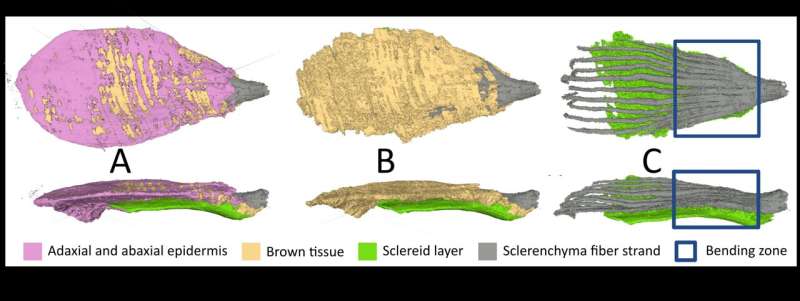New insights into the movement of pine cone scales

Pine cones open when dry and close when wet. In this way, pine seeds are released only under advantageous conditions, namely when it is dry and the seeds can be carried far by wind. Opening and closing is of particular interest to researchers because the actuation is passive, that is, it does not consume metabolic energy. This is why the pine cone has already served as a model for biomimetic flap systems that react to moisture and are used, for example, in building envelopes to regulate the climate.
A team led by Prof. Dr. Jürgen Rühe, Carmen Eger and Prof. Dr. Thomas Speck from the Cluster of Excellence Living, Adaptive and Energy-autonomous Materials Systems (livMatS) at the University of Freiburg, Dr. Simon Poppinga from TU Darmstadt and Prof. Dr. Manfred Bischoff from the University of Stuttgart, in collaboration with researchers from TU Munich and project partners from BASF, has now analyzed in detail which tissue structures are involved in the actuation. The researchers show that the cone scales close due to several tissue layers, all of which absorb moisture. With the help of their findings, biomimetic flap systems with improved function could be created. The team published their findings in the journal Advanced Science.
Previous model assumes two functionally relevant tissue types
Until now, research assumed that the movements of the pine cone were mainly due to the interaction of two tissue layers in the scale: An upper, rigid layer that absorbs no or very little water, and a lower layer that swells and elongates due to moisture. In this process, it pushes the scale upward and the cone closes. If the lower layer dries and shrinks, it pulls the scale down again and the cone opens.
Fiber strands set bending process in motion
The scientists refute this simplified model in their analysis. They show that several tissue layers in the scale absorb water. The so-called sclerenchyma fibers are of particular importance. In the bilayer model, they are considered the main component of the rigid, upper tissue layer. In their analysis, however, the researchers come to the conclusion that although the fiber strands are rigid in the dry state, they soften when exposed to moisture and thus set the bending process in motion in the first place.
In addition, although the different tissues are made of chemically identical materials, their arrangement along the scale varies. For example, the scale consists of a bending zone and a longer flap-like periphery that does not contribute significantly to the bending process but is passively moved along with it. In their analysis, the researchers performed, for example, high-resolution 3D structural analyses, 3D deformation measurements, measurements of the water absorption of the different tissues, and biomechanical experiments.
More information: Carmen J. Eger et al, The Structural and Mechanical Basis for Passive‐Hydraulic Pine Cone Actuation, Advanced Science (2022). DOI: 10.1002/advs.202200458
Provided by Albert Ludwigs University of Freiburg















